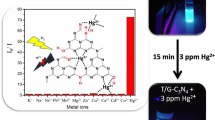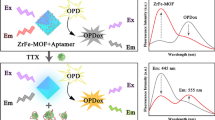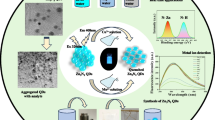Abstract
Hierarchical zinc oxide (ZnO) nanomaterials have been successfully synthesized using a biotemplated method. The morphology and structure of the produced samples were characterized by means of SEM, TEM, XRD, FTIR, etc. The result showed that hierarchical ZnO nanomaterial retained the porous network structure of the template. Trimethylamine (TMA) in aquatic products was effectively detected by a fluorescence resonance energy transfer (FRET)–based molecular sensor using ZnO as energy donors and tetrasodium-meso-tetra(4-sulfonatophenyl) porphine dodecahydrate (TPPS) as energy acceptors. The FRET efficiency was reduced by the addition of TMA, due to the combination between TPPS and TMA. The fluorescence intensity of ZnO (donor) would decrease gradually with the increasing concentration of TMA. Under the optimal conditions, a linear correlation was established between the fluorescence intensity ratio ITPPS/IZnO and the concentration of TMA in the range of 2.67 × 10−11–6.67 × 10−6 mol/L and 1.33 × 10−5–6.67 × 10−4 mol/L with a detection limit of 7.51 × 10−12 mol/L. The proposed method was successfully applied to the determination of TMA in real fish samples with satisfactory results.





Similar content being viewed by others
References
Alsultany FH, Hassan Z, Ahmed NM (2016) Catalyst-free growth of ZnO nanowires on ITO seed layer/glass by thermal evaporation method: effects of ITO seed layer laser annealing temperature. Superlattice Microst 92:68–79. https://doi.org/10.1016/j.spmi.2016.01.038
Baskaran D, Mays JW, Zhang XP, Bratcher MS (2005) Carbon nanotubes with cova-lently linked porphyrin antennae: photoinduced electron transfer. J Am Chem Soc 127:6916–6917. https://doi.org/10.1021/ja0508222
Botta JR (1995) Evaluation of seafood freshness quality, vol. 199. VCH, Weinheim, pp 446–448. https://doi.org/10.1002/food.19960400621
Brittle SA, Richardson TH, Dunbar ADF, Turega SM, Hunter CA (2011) Tuning free base tetraphenylporphyrins as optical sensing elements for volatile organic analytes. J Mater Chem 21:4882–4887. https://doi.org/10.1039/C0JM03670F
Capone S, Mongelli S, Rella R, Siciliano P, Valli L (1999) Gas sensitivity measurements on NO2 sensors based on copper(II)tetrakis(n-butylaminocarbonyl)phthalocyanine LB films. Langmuir 15:1748–1753. https://doi.org/10.1021/la980608
Cho YH, Ko YN, Kang YC, Kim D, Lee JH (2014) Ultraselective and ultrasensitive detection of trimethylamine using MoO3 nanoplates prepared by ultrasonic spray pyrolysis. Sensors Actuators B Chem 195:189–196. https://doi.org/10.1016/j.snb.2014.01.021
Demes T, Ternon C, Morisot F, Riassetto D, Legallais M, Roussel H, Langlet M (2017) Mechanisms involved in the hydrothermal growth of ultra-thin and high aspect ratio ZnO nanowires. Appl Surf Sci 410:423–431. https://doi.org/10.1016/j.apsusc.2017.03.086
Dhanalakshmi A, Palanimurugan A, Natarajan B (2017) Enhanced antibacterial effect using carbohydrates biotemplate of ZnO nano thin films. Carbohydr Polym 168:191–200. https://doi.org/10.1016/j.carbpol.2017.03.071
Dorfman A, Kumar N, Hahm J (2006) Nanoscale ZnO-enhanced fluorescence detection of protein interactions. Adv Mater 18:2685–2690. https://doi.org/10.1002/adma.200502616
Drain CM, Varotto A, Radivojevic I (2009) Self-organized porphyrinic materials. Chem Rev 109:1630–1658. https://doi.org/10.1021/cr8002483
Du JP, Wang HY, Zhao RH, Xie YJ, Yao HL (2013) Surfactant-assisted synthesis of the pencil-like zinc oxide and its sensing properties. Mater Lett 107:259–261. https://doi.org/10.1016/j.matlet.2013.06.014
Giovanni B, de la Torre G, Torres T (2016) Phthalocyanine-nanocarbon ensembles: from discrete molecular and supramolecular systems to hybrid nanomaterials. Acc Chem Res 4:900–910. https://doi.org/10.1021/ar5004384
Hall SR, Swinerd VM, Newby FN, Collins AM, Mann S (2006) Fabrication of porous titania (brookite) microparticles with complex morphology by sol-gel replication of pollen grains. Chem Mater 18:598–600. https://doi.org/10.1021/cm0524087
Huang MH, Mao S, Feick H, Yan H, Wu Y, Kind H, Weber E, Russo R, Yang P (2001) Room-temperature ultraviolet nanowire nanolasers. Science 292:1897–1899. https://doi.org/10.1126/science.1060367
Jiang X, Liu Y, Hao HJ, Xu Y, Huang JL, Sun DH, Li QB (2018) Rape pollen-templated synthesis of C,N self-doped hierarchical TiO2 for selective hydrogenation of 1,3-butadiene. ACS Sustain Chem Eng 6:882–888. https://doi.org/10.1021/acssuschemeng.7b03228
Johnson BJ, Anderson NE, Charles PT, Malanoski AP, Melde BJ, Nasir M, Deschamps JR (2011) Porphyrin-embedded silicate materials for detection of hydrocarbon solvents. Sensors 11:886–904. https://doi.org/10.3390/s110100886
Kim J, Lim SH, Yoon Y, Thangadurai D, Yoon S (2011) A fluorescent ammonia sensor based on a porphyrin cobalt(II)–dansyl complex. Tetrahedron Lett 52:2645–2648. https://doi.org/10.1016/j.tetlet.2011.03.048
Ko SH, Lee D, Kang HW, Nam KH, Yeo JY, Hong SJ, Grigoropoulos CP, Sung HJ (2011) Nanoforest of hydrothermally grown hierarchical ZnO nanowires for a high efficiency dye-sensitized solar cell. Nano Lett 11:666–671. https://doi.org/10.1021/nl1037962
Kołodziejczak-Radzimska A, Jesionowski T (2014) Zinc oxide-from synthesis to application: a review. Materials 7:2833–2881. https://doi.org/10.3390/ma7042833
Li Z, Yang R, Yu M, Bai F, Li C, Wang ZL (2008) Cellular level biocompatibility and biosafety of ZnO nanowires. J Phys Chem C 112:20114–20117. https://doi.org/10.1021/jp808878p
Li SM, Zhang LX, Zhu MY, Ji GJ, Zhao LX, Yin J, Bie LJ (2017) Acetone sensing of ZnO nanosheets synthesized using room-temperature precipitation. Sensors Actuators B Chem 247:611–623. https://doi.org/10.1016/j.snb.2017.04.007
Liau CK, Huang JS (2017) Energy-level variations of Cu-doped ZnO fabricated through sol-gel processing. J Alloys Compd 702:153–160. https://doi.org/10.1016/j.jallcom.2017.01.174
Liu Z, Fan T, Zhang D, Gong X, Xu J (2009) Hierarchically porous ZnO with high sensitivity and selectivity to H2S derived from biotemplates. Sensors Actuators B Chem 136:499–509. https://doi.org/10.1016/j.snb.2008.10.043
Longsu X (2003) Determination of trimethylamine nitrogen in ham, Chinese National Standard, GB/T5009. 179–2003
Mitsubayashi K, Kubotera Y, Yano K, Hashimoto Y, Kon T, Nakakura S, Nishi Y, Endo H (2004) Trimethylamine biosensor with flavin-containing monooxygenase type 3 (FMO3) for fish-freshness analysis. Sensors Actuators B Chem 103:463–467. https://doi.org/10.1016/j.snb.2004.05.006
Qi Q, Zou YC, Fan MH, Liu YP, Gao S, Wang PP, He WDJ, Li GD (2014) Trimethylamine sensors with enhanced anti-humidity ability fabricated from La0.7Sr0.3FeO3 coated In2O3-SnO2 composite nanofibers. Sensors Actuators B Chem 203:111–117. https://doi.org/10.1016/j.snb.2014.06.082
Qin L, Liu M, Wu Y, Xu Z, Guo X, Zhang G (2016) Bioinspired hollow and hierarchically porous MOx (M =Ti, Si)/carbon microellipsoids supported with Fe2O3 for heterogenous photochemical oxidation. Appl Catal B Environ 194:50–60. https://doi.org/10.1016/j.apcatb.2016.04.051
Raulu M, Rashid MH, Paira TK (2010) Ascorbate-assisted growth of hierarchical ZnO nanostructures: sphere, spindle, and flower and their catalytic properties. Langmuir 26:8769–8782. https://doi.org/10.1021/la904507q
Sivalingam Y, Martinelli E, Catini A, Magna G, Pomarico G, Basoli F, Paolesse R, Natale CD (2012) Gas-sensitive photoconductivity of porphyrin-functionalized ZnO nanorods. J Phys Chem C 116:9151–9157. https://doi.org/10.1021/jp302225u
Song F, Su H, Han J, Lau WM, Moon WJ, Zhang D (2012) Bioinspired hierarchical tin oxide scaffolds for enhanced gas sensing properties. J Phys Chem C 116:10274–10281. https://doi.org/10.1021/jp2118136
Spadavecchia J, Ciccarella G, Siciliano P, Capone S, Rella R (2004) Spin-coated thinfilms of metal porphyrin-phthalocyanine blend for an optochemical sensor of alcohol vapours. Sensors Actuators B Chem 100:88–93. https://doi.org/10.1016/j.snb.2003.12.027
Wang ZL (2004) Zinc oxide nanostructures: growth, properties and applications. J Phys Condens Matter 16:829–858. https://doi.org/10.1088/0953-8984/16/25/R01
Wang ZL, Song J (2006) Piezoelectric nanogenerators based on zinc oxide nanowire arrays. Science 11:666–671. https://doi.org/10.1126/science.1124005
Wang L, Tian X, Yang S, Xu Z, Wang W, Bai X (2012) Dynamic nanomechanics of zinc oxide nanowires. Appl Phys Lett 100:3084. https://doi.org/10.1063/1.4704919
Wang J, Li J, Wang Y, Gao M, Zhang X, Deng C (2016) A novel double-component MOAC honeycombcomposite with pollen grains as a template for phosphoproteomics research. Talanta 154:141–149. https://doi.org/10.1016/j.talanta.2016.03.061
Wei L, Tian K, Jin Y, Zhang X, Guo X (2016a) Three-dimensional porous hollow microspheres of activated carbon for high-performance electrical double-layer capacitors. Microporous Mesoporous Mater 227:210–218. https://doi.org/10.1007/s00604-018-2973-5
Wei L, Tian K, Zhang X, Jin Y, Shi T, Guo X (2016b) 3D porous hierarchical microspheres of activated carbon from nature through nanotechnology for electrochemical double-layer capacitors. ACS Sustain Chem Eng 4:6463–6472. https://doi.org/10.1021/acssuschemeng.6b01227
Yan SH, Ma SY, Xu XL, Lu Y, Bian HQ, Liang XY, Jin WX, Yang HM (2016) Synthesis and gas sensing application of porous CeO2-ZnO hollow fibers using cotton as biotemplates. Mater Lett 165:9–13. https://doi.org/10.1016/j.matlet.2015.11.095
Ye Z, Wang T, Wu S, Ji X, Zhang Q (2017) Na-doped ZnO nanorods fabricated by chemical vapor deposition and their optoelectrical properties. J Alloys Compd 690:189–194. https://doi.org/10.1016/j.jallcom.2016.08.100
Zak AK, Majid WHA, Darroudi M, Yousefi R (2011) Synthesis and characterization of ZnO nanoparticles prepared in gelatin media. Mater Lett 65:70–73. https://doi.org/10.1016/j.matlet.2010.09.029
Zhang H, Xu C, Sheng PK, Chen YJ, Yu L, Li QH (2013) Synthesis of ZnO hollow spheres through a bacterial template method and their gas sensing properties. Sensors Actuators B Chem 181:99–103. https://doi.org/10.1016/j.snb.2013.01.002
Zhao LH, Zhang R, Zhang J, Sun SQ (2012) Synthesis and characterization of biocompatible ZnO nanoparticles. CrystEngComm 14:945–950. https://doi.org/10.1039/C1CE05621B
Zhao D, Song HJ, Hao LY, Liu X, Zhang LC, Lv Y (2013) Luminescent ZnO quantum dots for sensitive and selective detection of dopamine. Talanta 107:133–139. https://doi.org/10.1016/j.talanta.2013.01.006
Zhou M, Zang DL, Zhai XL, Gao ZX, Zhang WB, Wang CY (2016) Preparation of biomorphic porous zinc oxide by wood template method. Ceram Int 42:10704–10710. https://doi.org/10.1016/j.ceramint.2016.03.188
Funding
This study was funded by a grant from the National Natural Science Foundation of China (no. 31501564), the Research Project from Science & Technology Department of Liaoning Province of China (no. 2015103020), the Team Support Program for the Taishan Scholar of Blue Industry Leading Personnel of Shandong Province of China (LZBZ2015-19), and Open Foundation of Food Safety Key Laboratory of Liaoning Province (LNSAKF2013012).
Author information
Authors and Affiliations
Corresponding authors
Ethics declarations
Conflict of Interest
Gao Xue declares that she has no conflict of interest. Liu Yutong declares that she has no conflict of interest. Wang Yu declares that she has no conflict of interest. Zhang Qiang declares that he has no conflict of interest. Liu Xiuying declares that she has no conflict of interest. Tang Yiwei declares that he has no conflict of interest. Li Jiangrong declares that he has no conflict of interest.
Informed Consent
In case humans are involved, informed consent was obtained from all individual participants included in the study. If not applicable to the study, informed consent was not applicable.
Ethical Approval
This article does not contain any studies with human participants or animals performed by any of the authors.
Additional information
Publisher’s Note
Springer Nature remains neutral with regard to jurisdictional claims in published maps and institutional affiliations.
Electronic supplementary material
ESM 1
(DOC 713 kb)
Rights and permissions
About this article
Cite this article
Gao, X., Liu, Y., Wang, Y. et al. A Fluorescence Resonance Energy Transfer (FRET) Biosensor Based on Zinc Oxide (ZnO) and Porphyrin for the Detection of Trimethylamine in Aquatic Products. Food Anal. Methods 12, 1585–1593 (2019). https://doi.org/10.1007/s12161-019-01488-6
Received:
Accepted:
Published:
Issue Date:
DOI: https://doi.org/10.1007/s12161-019-01488-6




